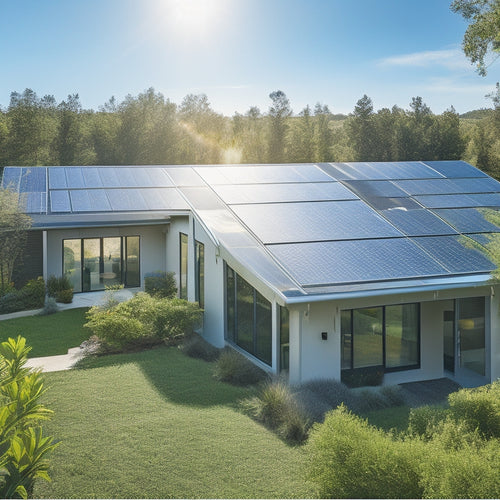
A Step-by-Step Battery Storage System Installation Guide
Share
You'll start by evaluating your renewable energy options, such as solar panels or wind power, and assess their compatibility with your site conditions. Next, you'll choose a deep cycle battery type and consider its capacity to balance energy needs and battery longevity. When selecting a battery, balance the depth of discharge (DOD) and charge cycles to determine ideal capacity. Proper planning also involves a 10-20% oversize buffer for unexpected demands. Carefully monitor charging cycle depth to maintain efficient battery operation. As you continue to plan your battery storage system installation, you'll also need to evaluate peak hour usage and TOU tariffs.
At a Glance
- Assess energy needs and site conditions to determine the ideal battery storage system configuration.
- Select compatible battery and renewable energy systems, such as solar or wind power, for seamless integration.
- Plan battery capacity by evaluating depth of discharge (DOD) and charge cycles limit to ensure optimal performance.
- Install battery systems in well-ventilated areas, away from extreme temperatures, and monitor charging cycle depth for longevity.
- Consider Time-of-Use tariffs and charge battery systems during off-peak hours to maximize energy savings and reduce costs.
Increased Energy Independence
When you integrate a battery storage system with renewable energy options, such as solar or wind power, you're taking a significant step towards increased energy independence.
By storing excess energy generated by these systems, you can reduce your reliance on the grid and minimize the impact of power outages or fluctuations.
This setup allows for efficient energy management systems that can integrate with solar panels for optimized usage, and also helps maximize energy capacity and minimize upkeep with reliable energy storage options such as deep cycle batteries deep cycle options.
This setup will allow you to optimize your energy usage and make the most of your on-site power generation.
Renewable Energy Options
Your shift to renewable energy options can greatly enhance your energy independence. By integrating solar panels into your battery storage system, you can utilize the power of the sun to generate electricity.
When selecting solar panels, consider factors such as panel efficiency, durability, and compatibility with your battery storage system. Confirm that your solar panels are designed to work seamlessly with your battery management system (BMS) to maximize energy storage and release.
If you're considering wind power, assess your site's wind turbine compatibility. Take into account factors such as wind speed, direction, and turbulence to determine the suitability of a wind turbine for your location.
When integrating a wind turbine into your battery storage system, verify that the turbine's power output is compatible with your BMS and battery bank. Properly sizing and configuring your renewable energy system is essential to achieving peak performance and energy independence.
Carefully evaluate your energy needs and site conditions to determine the best renewable energy solution for your battery storage system.
Reduced Grid Reliance
| Benefits | Description | Impact |
|---|---|---|
| Energy Security | Reduced reliance on grid power | Increased control over energy supply |
| Grid Stability | Decreased peak demand during outages | Reduced strain on grid infrastructure |
| Cost Savings | Lower energy bills from reduced grid usage | Increased financial independence |
| Environmental Benefits | Reduced carbon footprint from renewable energy sources | Contribution to a sustainable future |
Reduced Peak Hour Costs
When you install a battery storage system, you can considerably reduce your peak hour costs by analyzing your energy usage patterns during these periods.
This analysis is essential in understanding how to optimize your energy storage and consumption, especially if you're on a Time-of-Use (TOU) tariff plan, which charges different rates based on the time of day.
By identifying your peak hour usage, you can adjust your energy storage and consumption strategies to minimize your costs during these periods.
For instance, you can optimize your energy usage by leveraging the benefits of energy independence and reducing your reliance on the grid.
Additionally, you can also take advantage of potential savings of up to $150/month during peak hours and an additional $50/month during off-peak usage.
Peak Hour Analysis
One key strategy for optimizing battery storage system performance is to analyze its potential impact on reducing peak hour costs. This involves evaluating your energy consumption patterns to identify periods of high demand. By doing so, you can configure your battery storage system to provide power during these peak hours, thereby reducing your reliance on the grid.
To conduct a peak hour analysis, you'll need to gather data on your energy consumption patterns. This can be done using smart meters or energy monitoring systems. Analyze the data to identify the times of day when your energy consumption is highest. Typically, these periods occur during morning and evening hours when household appliances and heating/cooling systems are in use.
To maximize battery efficiency, you should configure your battery storage system to discharge during these peak hours. This will help reduce your energy consumption from the grid, resulting in lower energy bills.
Time-of-Use Tariffs
To further reduce peak hour costs, you'll want to contemplate Time-of-Use (TOU) tariffs, which charge different rates for energy consumption based on the time of day. This approach allows you to manage your energy usage effectively, optimizing your battery storage system for maximum savings.
Understanding TOU tariffs is vital for efficient time management, as it helps you identify periods of high and low energy demand. You'll need to analyze your tariff structures to determine the most cost-effective periods for energy consumption.
Typically, TOU tariffs consist of peak, shoulder, and off-peak rates, with varying charges for each period. By shifting your energy usage to off-peak hours, you can considerably reduce your energy costs. This may involve charging your battery storage system during off-peak hours and using the stored energy during peak periods.
It's important to work with your energy provider to determine the best tariff structure for your specific needs. By optimizing your energy usage with TOU tariffs, you can maximize your energy savings and achieve greater freedom from high energy costs.
Properly implemented, TOU tariffs can considerably reduce your peak hour costs, enhancing your overall energy independence.
Deep Cycle Battery Type
When selecting a deep cycle battery type for your battery storage system, you'll want to evaluate its life span and how it relates to the charging cycle depth. A battery's life span is measured in cycles, with a cycle being a full discharge followed by a full recharge, and its capacity to handle deep discharges is vital.
You'll need to assess the battery's depth of discharge (DOD) tolerance, as it greatly affects the overall battery life and system performance. Advanced battery management systems, such as those found in top-rated systems, can enhance charging/discharging for longevity.
Proper maintenance, including monitoring temperature, state of charge, and regular calibration, is also fundamental for peak performance.
Battery Life Span
The lifespan of a deep cycle battery, a critical component in a battery storage system, hinges on how well you maintain and operate it. Proper battery maintenance tips can greatly extend the life of your deep cycle battery.
Keep your batteries in a well-ventilated area, away from direct sunlight, and avoid extreme temperatures. Regularly check the electrolyte levels and top them off as needed. Also, verify the terminals are clean and free of corrosion.
Monitor the battery's state of charge and avoid deep discharging, as this can reduce its lifespan. Consider implementing a battery management system to regulate charging and discharging.
When it's time to replace your battery, investigate battery recycling options to minimize waste and reduce the environmental impact.
A well-maintained deep cycle battery can last for 5 to 10 years or more, depending on the quality of the battery and operating conditions.
Charging Cycle Depth
Although deep cycle batteries are designed to handle repeated charge and discharge cycles, their lifespan is markedly affected by charging cycle depth. When you're planning your battery storage system, you need to take into account the charging cycle depth to enhance charging efficiency and extend battery lifespan.
A charging cycle depth refers to the percentage of the battery's capacity that's used before it's recharged. For example, if your battery has a 100Ah capacity and you discharge it to 50% (50Ah), you've completed a 50% depth of discharge (DOD). The key to extending your battery's lifespan is to avoid extreme DODs.
While it's not necessary to maintain a 0% DOD, keep it below 50% whenever possible. This will help you maintain maximum charging efficiency and prolong battery lifespan.
When it comes to battery maintenance, it's crucial to monitor your charging cycle depth and adjust your usage accordingly. By doing so, you'll guarantee your battery storage system operates efficiently and effectively, giving you the freedom to enjoy your off-grid lifestyle.
Proper battery maintenance will also prevent premature wear, ensuring your system lasts for years to come.
Battery Capacity Considerations
When selecting a battery storage system, you must consider its capacity to guarantee it meets your needs.
Two critical factors to evaluate are the battery's depth of discharge (DOD) and charge cycles limit, as they directly affect its overall capacity and lifespan.
To enhance your system's performance and efficiency, it's crucial to calculate energy requirements and choose the right battery size, incorporating a 10-20% oversize buffer for unexpected demands Energy Requirements.
You'll need to balance these factors to determine the ideal battery capacity for your specific application.
Depth of Discharge
To guarantee you get the most out of your battery storage system, understanding the concept of Depth of Discharge (DOD) is essential. DOD refers to the percentage of a battery's capacity that's used before it's recharged.
It's important to manage DOD carefully, as excessive discharging can reduce battery health and lifespan. When choosing a DOD, consider your energy needs and discharge rates. A higher DOD may provide more energy, but it can also increase the risk of battery degradation.
For example, if you have a 10 kWh battery and set the DOD to 80%, you'll be using 8 kWh of energy before recharging. This leaves 20% of the battery's capacity in reserve, which helps maintain battery health.
A good rule of thumb is to set the DOD between 50% to 80% to balance energy needs with battery longevity. However, this may vary depending on your specific system and energy requirements.
It's crucial to monitor your battery's state of charge and adjust the DOD accordingly to guarantee optimal performance and extend its lifespan. By managing DOD effectively, you can maximize your battery's capacity and maintain its overall health.
Charge Cycles Limit
Beyond the depth of discharge, another vital factor to reflect on in battery storage system installation is the charge cycles limit.
You'll want to think about how many charge cycles your battery can handle before its capacity starts to degrade. A charge cycle consists of a full discharge followed by a full recharge. Most battery manufacturers provide a charge cycle rating, which indicates the number of cycles the battery can handle before its capacity drops to 80% of its original value.
When choosing a battery, you should look for one with a high charge cycle rating to guarantee it can handle the demands of your installation.
Charge cycle optimization is essential in extending the lifespan of your battery. You can achieve this by avoiding frequent deep discharges, keeping the battery away from extreme temperatures, and confirming proper maintenance.
Battery technology advancements have led to the development of more durable and efficient batteries, making it easier to achieve charge cycle optimization.
Lower Carbon Footprint Option
To lower your carbon footprint with a battery storage system, you'll want to contemplate integrating renewable energy sources, such as solar or wind power, to charge your batteries.
This approach reduces your reliance on non-renewable energy sources and minimizes greenhouse gas emissions.
Renewable Energy Sources
Renewable energy sources, such as solar and wind power, are becoming increasingly popular as a lower carbon footprint option for battery storage system installations. You're probably pondering integrating these sources into your system to reduce your reliance on traditional energy sources. Solar panel integration and wind energy compatibility are essential aspects to take into account when designing your system.
Here are some key benefits of using renewable energy sources with battery storage systems:
| Renewable Energy Source | Key Benefits |
|---|---|
| Solar Power | Reduces energy costs, increases energy independence, and provides a reliable source of power during outages |
| Wind Power | Offers a low-maintenance, long-term source of energy, and can be used in conjunction with solar power for a hybrid system |
| Solar-Wind Hybrid | Provides a reliable and efficient source of energy, and can be used in areas with limited sunlight or wind |
| Geothermal Power | Offers a constant and reliable source of energy, and can be used in areas with suitable geology |
| Hydro Power | Provides a low-cost and reliable source of energy, and can be used in areas with suitable water resources |
Frequently Asked Questions
Do I Need a Battery Storage System Permit?
You'll likely need a permit for your battery storage system, as local regulations often require one to guarantee safety and compliance. Researching these requirements can also help you factor them into your installation costs.
Can I Install the System Myself Safely?
You can install the system yourself, but guarantee you take necessary safety precautions, such as wearing protective gear and following manufacturer instructions. Familiarize yourself with specialized installation tools to minimize risks and avoid electrical shocks.
How Long Does a Typical Installation Take?
You'll find installation timelines vary greatly, depending on project factors like system size, complexity, and local regulations. Generally, a residential setup takes 2-5 days, while larger commercial projects may require several weeks or even months.
Are There Any Recommended Battery Maintenance Schedules?
To guarantee a long battery lifespan, you'll want to follow a maintenance schedule with regular checks on charge levels, equalization, and cleaning. Implementing these maintenance tips helps you maximize efficiency and freedom from energy concerns.
Can I Upgrade My Existing System Later?
Imagine upgrading your smartphone's storage - you can do the same with your battery system. You'll want to guarantee system compatibility and future scalability, so choose a modular design that allows for easy upgrades later.
Explore More
With your battery storage system up and running, you've taken a leap towards energy independence. Now, you're the ruler of your energy domain, and the grid is no longer pulling the strings. Like a well-oiled machine, your system is humming along, reducing peak hour costs and your carbon footprint. The bottom line: your wallet and the planet are both smiling, thanks to your smart investment in battery storage.
Related Posts
-

Why Outdoor Solar Lighting Systems Are Sustainable
Outdoor solar lighting systems are sustainable because they utilize renewable energy, drastically reducing your carbo...
-

High-Efficiency Solar Battery Chargers for Remote Areas
High-efficiency solar battery chargers are essential for your off-grid energy needs in remote areas. They maximize en...
-

Installing Metal Solar Roofs for Maximum Energy Efficiency
Installing metal solar roofs can drastically enhance your home's energy efficiency and durability. These roofs withst...


